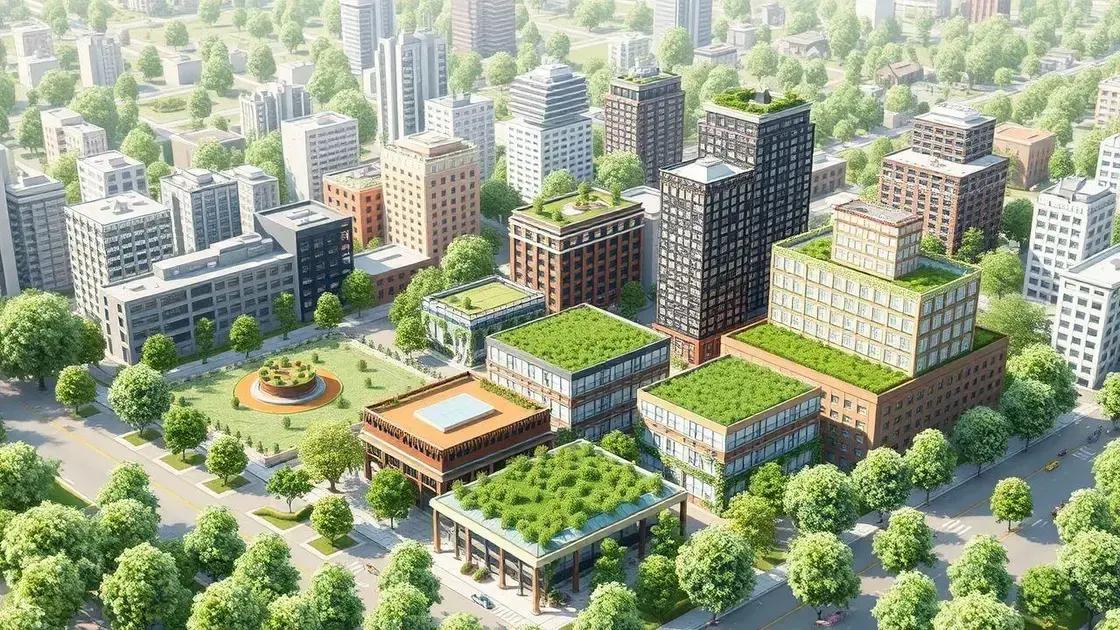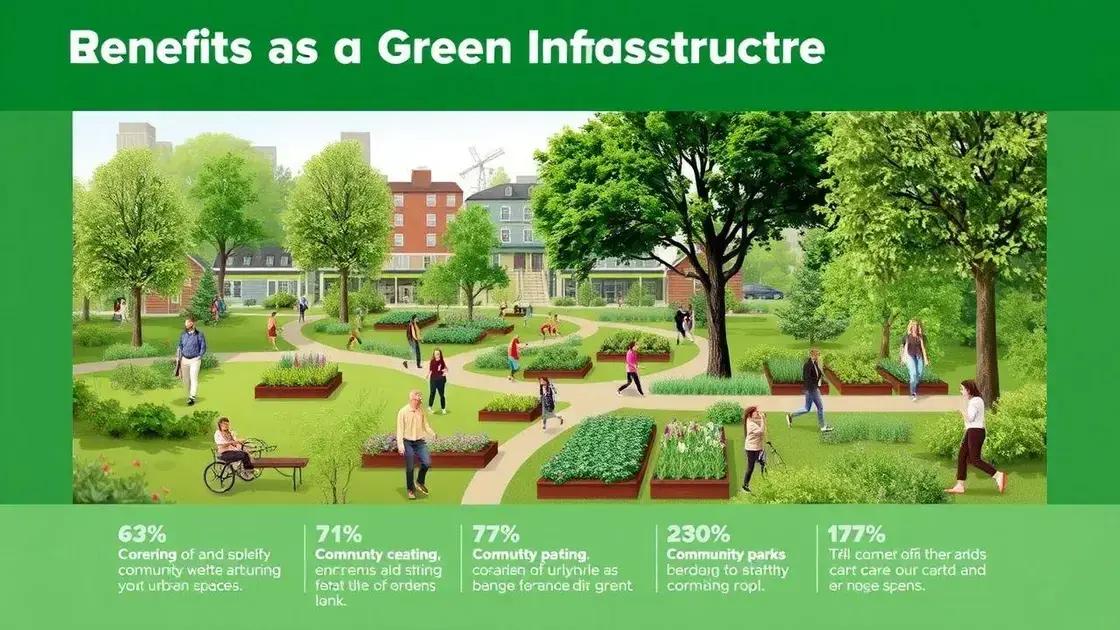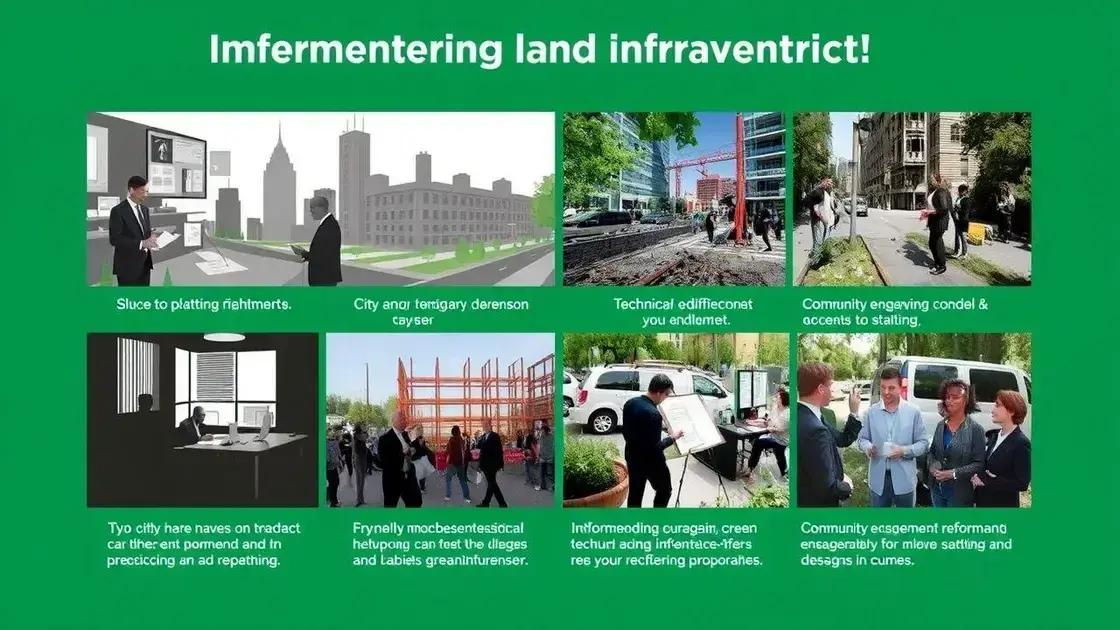Insights on green infrastructure headlines that inspire change

Green infrastructure utilizes natural systems to improve urban environments, offering benefits such as enhanced air quality, effective stormwater management, and increased biodiversity while addressing challenges related to funding, technical expertise, and community engagement.
Insights on green infrastructure headlines reveal the ongoing evolution in urban planning. Have you ever noticed how nature and city life can coexist beautifully? This article explores the role of green infrastructure in creating sustainable urban environments.
Understanding green infrastructure concepts
Understanding green infrastructure concepts plays a vital role in shaping sustainable cities. This approach emphasizes the importance of using nature-based solutions to manage stormwater, improve air quality, and enhance urban biodiversity.
One key aspect of green infrastructure is the integration of natural systems into urban settings. For instance, planting trees and creating green roofs can significantly reduce urban heat and help control rainwater runoff. These efforts not only enhance the cityscape but also promote a healthier environment.
Components of green infrastructure
Green infrastructure includes various components that work together to create eco-friendly urban spaces. Some common elements are:
- Green roofs: These are rooftops covered with vegetation that help insulate buildings and absorb rainwater.
- Permeable pavements: Designed to allow water to seep through, reducing surface runoff and protecting water quality.
- Urban forests: Trees planted within cities improve air quality and provide cooling shade.
- Rain gardens: These landscaped areas are designed to absorb rainwater and filter pollutants.
In addition to these components, community involvement is crucial in fostering green infrastructure. Engaging residents in the planning process can help ensure their needs are met while promoting a sense of ownership over local green spaces. When communities are involved, they can advocate for green initiatives and participate in maintaining these vital areas.
Moreover, understanding the benefits of green infrastructure is essential. It not only enhances the aesthetics of urban areas but also improves residents’ quality of life. For instance, green spaces offer recreational opportunities, promote mental well-being, and enhance social interactions. Furthermore, they contribute to energy efficiency by reducing urban heat island effects.
The role of green infrastructure in climate resilience
As cities increasingly face the impacts of climate change, green infrastructure provides adaptable solutions. For example, by installing green roofs and creating urban wetlands, cities can better manage heavy rainfall and reduce flooding risks.
Furthermore, these solutions support biodiversity, providing habitats for various species even in densely populated areas. This blending of nature with urban development not only mitigates environmental impacts but creates vibrant ecosystems within cities, making them more resilient.
Key benefits of green infrastructure

Implementing green infrastructure offers numerous advantages that can enhance urban areas significantly. By integrating natural elements into our cities, we can address environmental issues while improving overall quality of life.
Environmental Benefits
One of the most important benefits of green infrastructure is its positive impact on the environment. It helps in managing stormwater, reducing urban heat, and improving air quality. For instance, green roofs can absorb rainwater, alleviating pressure on drainage systems during heavy rains.
- Stormwater management: Green infrastructure absorbs and filters rainwater, controlling runoff and preventing flooding.
- Improved air quality: Plants absorb pollutants, thereby enhancing the air we breathe.
- Climate regulation: Vegetation helps moderate temperatures, reducing the heat island effect in urban areas.
- Biodiversity support: Green spaces create habitats for various species, promoting ecological balance.
These environmental benefits not only lead to healthier ecosystems but also contribute to making cities more sustainable.
Social and Economic Advantages
In addition to environmental perks, green infrastructure provides social and economic advantages. Communities can benefit drastically from access to parks and green spaces. These areas encourage physical activity and social interaction among residents.
Moreover, the implementation of green infrastructure can boost local economies. Businesses may thrive near attractive green areas, drawing in more customers. Studies show that real estate values can increase in neighborhoods that feature well-maintained parks and gardens. This enhancement of property values can lead to increased tax revenue for cities.
Importantly, green infrastructure may also contribute to mental well-being. Studies indicate that spending time in nature reduces stress and promotes relaxation. Parks and green spaces can serve as communal areas where individuals connect and engage, enhancing the sense of community.
With these key benefits, it becomes clear that green infrastructure is not just an option but a necessity for future urban planning. As cities continue to grow, prioritizing natural solutions will lead to a healthier, more sustainable environment for everyone.
Innovative examples worldwide
Across the globe, cities are implementing innovative green infrastructure solutions to address urban challenges. These examples serve as models for sustainability and environmental stewardship, demonstrating the potential of integrating nature into urban planning.
Singapore’s Gardens by the Bay
One of the most famous examples is Gardens by the Bay in Singapore. This park features iconic structures known as Supertrees, which are vertical gardens that collect rainwater and generate solar power. Visitors can stroll through the Flower Dome and Cloud Forest, two climate-controlled conservatories showcasing diverse plant species.
The Supertrees also serve a dual purpose, providing shade during the day and transforming into a colorful light show at night. This combination of aesthetics and functionality highlights how urban spaces can be both beautiful and environmentally beneficial.
New York City’s High Line
Another innovative example is New York City’s High Line, an elevated linear park built on a former railway line. This project not only revitalizes a neglected area but incorporates native plants and habitats into its design. The High Line has become a beloved space for residents and tourists, promoting walking and community engagement.
- Improved biodiversity: The park includes various plant species that attract pollinators.
- Public art installations: The space features numerous art pieces, enhancing the cultural experience.
- Recreation areas: Visitors can enjoy seating, gardens, and event spaces.
The High Line exemplifies how reimagining urban infrastructure can foster community interaction while benefiting the environment.
Melbourne’s Urban Forest Strategy
In Australia, Melbourne has launched an Urban Forest Strategy aiming to increase tree canopy cover to 40 percent by 2040. This initiative focuses on planting trees, improving public green spaces, and utilizing technology to monitor the health of the urban forest.
By integrating trees into the urban landscape, the city hopes to bring numerous benefits, such as enhancing air quality and providing shaded areas. This ambitious plan reflects the growing recognition of trees as vital components of urban ecosystem health.
These innovative examples from around the world showcase how cities can creatively implement green infrastructure. From Singapore’s stunning gardens to New York’s revitalized High Line and Melbourne’s urban forest initiatives, each project demonstrates that integrating nature into urban environments can lead to sustainable and lively spaces.
Challenges in implementing green infrastructure

Despite the many benefits of green infrastructure, several challenges can arise during its implementation. Recognizing these challenges is crucial for cities aiming to adopt sustainable practices effectively.
Funding and Budget Constraints
One of the primary obstacles is securing adequate funding. Many cities operate with limited budgets, making it difficult to allocate money for green infrastructure projects. Initial costs can be high, even if long-term savings are expected. As a result, local governments often struggle to prioritize these projects over traditional infrastructure.
- Identifying funding sources: Cities must look for grants, public-private partnerships, and other funding opportunities.
- Long-term investment: It can be hard to justify upfront costs without immediate returns.
- Cost-benefit analysis: Demonstrating the economic advantages of green solutions can lead to better financial support.
These financial barriers can often delay or derail green infrastructure projects before they even begin.
Technical Challenges
Another significant challenge relates to the technical aspects of implementing green infrastructure. Municipalities may lack the necessary expertise or experience to design and maintain these systems effectively. Complex systems require specialized knowledge that may not always be readily available.
Additionally, the integration of green elements into existing urban environments can present difficulties. For example, retrofitting buildings with green roofs or creating rain gardens in dense urban settings may encounter spatial limitations.
Such challenges demand collaboration among engineers, urban planners, and ecologists to create effective solutions that work within the confines of existing structures.
Community Engagement and Participation
Successful implementation of green infrastructure relies heavily on community support and involvement. However, garnering community interest can be challenging. Residents may not fully understand the benefits of these projects or fear changes to their environment.
Informing and engaging the public is essential. Community outreach programs are crucial to educate residents about the value of green spaces, fostering a sense of ownership. Building trust between the community and local authorities can enhance cooperation and participation.
Ultimately, while green infrastructure presents several challenges, addressing these obstacles head-on allows cities to create sustainable, resilient environments.
FAQ – Frequently Asked Questions about Green Infrastructure
What is green infrastructure?
Green infrastructure refers to a network of natural and semi-natural systems in urban environments that help manage stormwater, reduce heat, and improve air quality.
How does green infrastructure benefit the environment?
It enhances urban biodiversity, mitigates urban heat island effects, and improves water quality by filtering pollutants through natural systems.
What are some examples of successful green infrastructure projects?
Notable examples include Singapore’s Gardens by the Bay, New York City’s High Line, and Melbourne’s Urban Forest Strategy, all promoting sustainable practices.
What challenges exist in implementing green infrastructure?
Challenges include securing funding, technical expertise, and engaging the community. Addressing these can help cities successfully integrate green practices.





